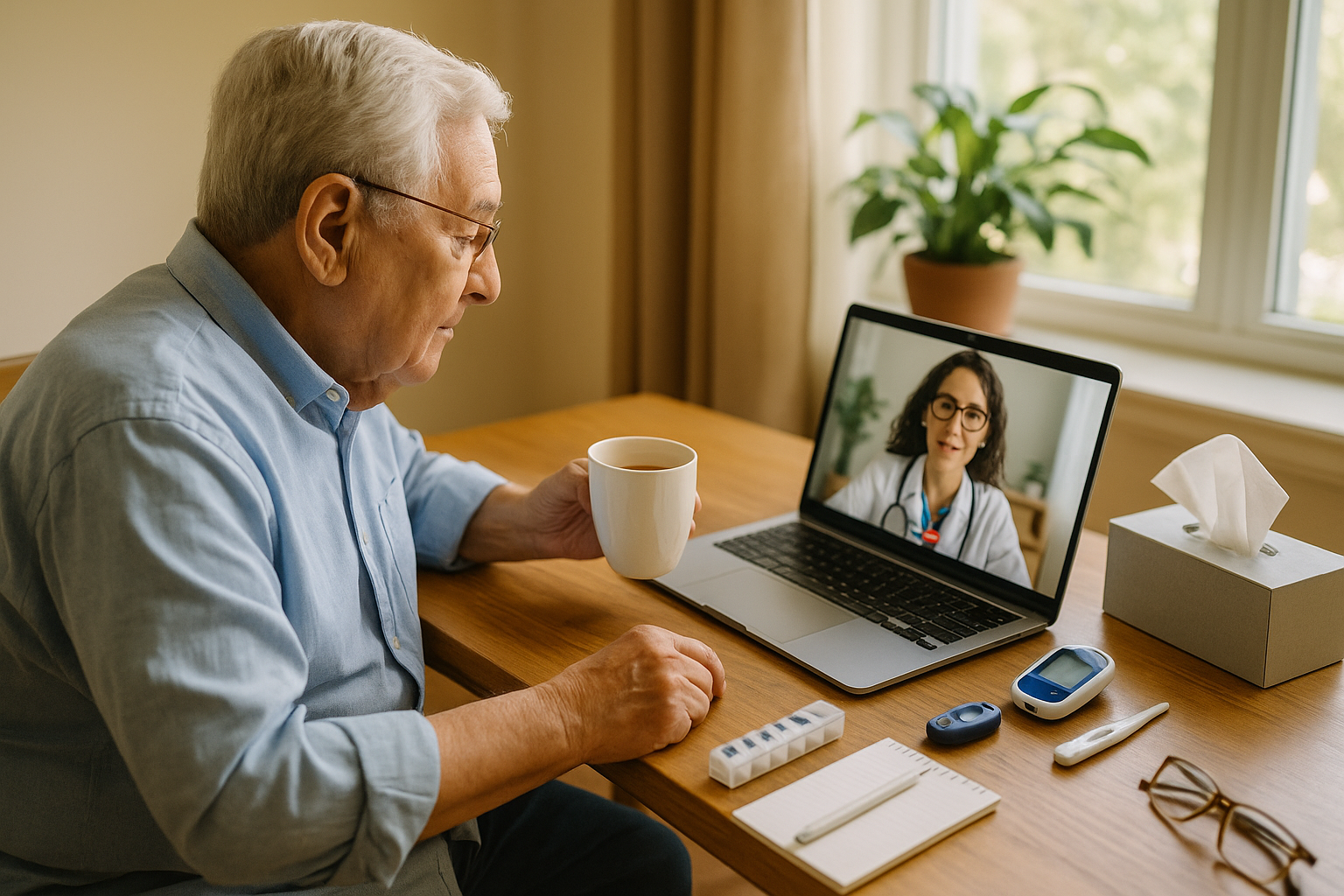Common Health Issues in Seniors That Telehealth Treats
- Home
- Common Health Issues in Seniors That Telehealth Treats

Common Health Issues in Seniors That Telehealth Treats
Estimated read time: 7–8 minutes
TL;DR: Telehealth is great for day-to-day concerns—colds/flu, rashes, pink eye, UTIs (screening and treatment when appropriate), medication refills, blood-pressure and diabetes tune-ups, mood/sleep issues, and follow-ups after hospital visits. Use in-person or emergency care for severe symptoms (trouble breathing, chest pain, stroke signs, heavy bleeding, new confusion).
What telehealth can handle well
1) Respiratory & minor infections
- Colds/flu/COVID-19: symptom plans, at-home test guidance, antivirals when appropriate, return-to-activity advice.
- Sinus/ear pain & sore throat: targeted questions to reduce unnecessary antibiotics; home-care tips; when an in-person look or testing is needed.
- Pink eye (conjunctivitis): video diagnosis is often sufficient; drops prescribed when appropriate.
2) Urinary & digestive
- Urinary tract infections (UTIs): symptom review, risk check, urine test orders if needed, and treatment plans.
- Constipation, reflux, heartburn: lifestyle and medication guidance; warning signs for in-person evaluation.
3) Chronic condition tune-ups
- High blood pressure: review 7-day home logs, adjust doses, teach cuff technique.
- Diabetes: review glucose/CGM patterns, adjust meds, foot-care coaching, lab orders.
- COPD/Asthma: inhaler and spacer technique checks, action plans, refills.
- Heart failure: daily weight strategy, diuretic plans, salt/fluid coaching, thresholds to call in.
- Thyroid & cholesterol: medication adjustments and lab follow-up.
4) Skin, eyes, and allergies
- Rashes, eczema, shingles concerns, insect bites: photo/video review; creams or antivirals when indicated; when to see dermatology.
- Dry eye/blepharitis & allergic rhinitis: step-wise treatment, device tips (warm compress, humidifier), and when to seek eye exam.
5) Pain, mobility & bone health
- Osteoarthritis flares, back/neck pain: safe pain plans, heat/ice/activity guidance, home exercises, and physical therapy referrals.
- Fall-risk screening: balance strategies, home-safety checklists, and DME referrals (cane, grab bars).
6) Mood, sleep & memory
- Depression/anxiety/insomnia: brief screening tools, medication options when appropriate, and therapy/sleep-clinic referrals.
- Memory concerns: history from family/caregiver, basic cognitive screening, labs/imaging orders, community resources.
7) Medication & care coordination
- Refills and deprescribing: reconcile bottles, simplify schedules, check interactions.
- Post-hospital follow-ups: review discharge plan, clarify meds, watch for complications, arrange labs and specialty follow-ups.
What telehealth can start online (with a local step)
- Vaccines sent to a nearby pharmacy (flu, COVID-19, pneumonia, shingles, Tdap, RSV if eligible).
- Labs & imaging orders (A1c, lipids, thyroid, urine tests, chest X-ray, bone density, mammogram/colon screening referrals).
- Home test kits where available (stool test for colon cancer screening, some STI kits).
- Specialist referrals and electronic consults.
When telehealth is not enough (go in person or ER)
- Chest pain/pressure; severe shortness of breath; blue or gray lips/face
- One-sided weakness, facial droop, trouble speaking; sudden severe headache
- Fainting, new or rapidly worsening confusion
- Heavy bleeding; severe abdominal pain; vomiting that won’t stop
- Fever in a very young infant visiting the home (for caregivers)
- High blood pressure ≥180/120 with concerning symptoms (chest pain, breathlessness, severe headache, vision changes)
A simple pre-visit checklist (print or save)
- Medication list or bottles (name, dose, how often) + allergies
- Home numbers:
- Blood pressure (two readings, morning/evening for a few days)
- Blood sugar/CGM summary if you track
- Weight (especially for heart failure)
- Oxygen level and temperature if available
- Symptoms: when they started, what helps/worsens, any home tests done
- Pharmacy & insurance info handy
- Care partner: invite a trusted family member if you’d like help
Home toolkit that makes telehealth visits better
- Upper-arm blood-pressure monitor (automatic, right cuff size)
- Thermometer
- Weight scale (same time daily)
- Glucose meter/CGM if you have diabetes
- Pulse oximeter (helpful for lung/heart conditions)
- Inhalers + spacer if you have COPD/asthma
- Pill organizer and a simple health log (paper or app)
Condition playbooks (quick reference)
High Blood Pressure
- Sit 5 minutes, feet flat, arm at heart level; two readings 1 minute apart; log the second.
- Share a 7-day average at visits; ask about goal numbers and side-effects.
Diabetes
- Bring fasting and post-meal values (or CGM trends).
- Ask for a sick-day plan; keep low-blood-sugar treatment handy.
COPD/Asthma
- Demonstrate inhaler + spacer on camera to check technique.
- Know your action plan (green/yellow/red steps) and when to escalate.
Heart Failure
- Daily morning weights; call if +2–3 lb overnight or +5 lb/week.
- Review salt/fluid limits and diuretic instructions.
UTI Symptoms
- Share onset, burning/urgency, fever/chills, back pain, and hydration.
- A urine test may be arranged; treatment plans are tailored to symptoms and history.
Tips for easier video visits
- Sit in a quiet, well-lit spot with the light in front of you.
- Prop the device at eye level; plug it in or charge it first.
- Use headphones if hearing is tough; enable captions if available.
- Keep glasses, hearing aids, and device chargers nearby.
- If video freezes, rejoin the link or switch to audio—your clinician will still help.
Caregiver corner
- Ask about proxy access so you can help schedule and view instructions.
- Keep a shared note with medication list, diagnoses, and emergency contacts.
- Join the visit to provide history and help with next-step planning.
How SendClinic can help
- Same-day video visits for common issues
- Refills and medication reviews to simplify regimens
- Action plans for blood pressure, diabetes, COPD/asthma, and heart failure
- Orders for labs/imaging and referrals when an in-person step is needed
- Clear, written instructions and follow-ups so nothing falls through the cracks
Educational content only. This article isn’t a substitute for medical advice. Always follow your clinician’s guidance and local emergency instructions.
- Share